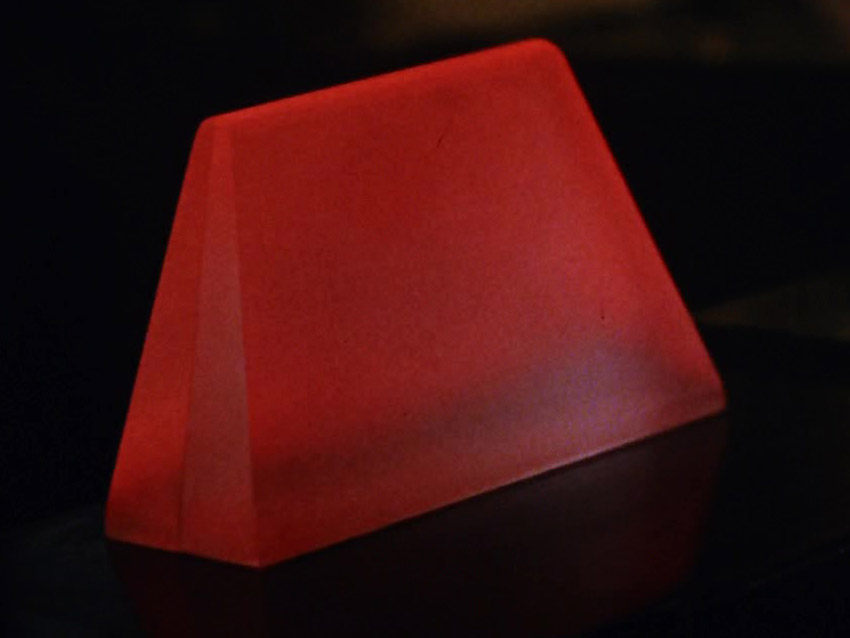Difference between revisions of "distress signal"
m |
|||
| Line 4: | Line 4: | ||
|}</div> | |}</div> | ||
{{BannerPrime}} | {{BannerPrime}} | ||
| − | Old-style distress signals—such as those in use aboard the {{link|Prime|S.S. Columbia||S.S. ''Columbia''}} when it disappeared in {{date|Prime|2236}}—were designed to interfere with systems and attract the attention of a ship's crew. When the {{link|Prime|U.S.S. Enterprise NCC-1701||U.S.S. ''Enterprise'' NCC-1701}} intercepted an old-style signal in {{date|Prime|2254}}, collision warnings and the {{link|Prime|red alert}} klaxon were activated in response.<ref name="TOS01"/> When the ''Enterprise'' was confronted by the {{link|Prime|First Federation}} Starship ''{{link|Prime|Fesarius}}'' during a tense {{link|Prime|first contact}} on {{link|Prime|Stardate}} {{link|Prime|2266|SD1512|1514.1}}, a small pilot vessel from the larger ship was disabled and sent out a weak distress signal.<ref name="TOS03"/> When {{link|Prime|Harry Mudd}} fled into an {{link|Prime|asteroid field}} to escape pursuit by the ''Enterprise'' on Stardate {{link|Prime|2266|SD1329|1329.1}}, he sent out a distress signal when his ship's power began to fail and was in danger of being destroyed.<ref name="TOS04"/> | + | Old-style distress signals—such as those in use aboard the {{link|Prime|S.S. Columbia||S.S. ''Columbia''}} when it disappeared in {{date|Prime|2236}}—were designed to interfere with systems and attract the attention of a ship's crew. When the {{link|Prime|U.S.S. Enterprise NCC-1701||U.S.S. ''Enterprise'' NCC-1701}} intercepted an old-style signal in {{date|Prime|2254}}, collision warnings and the {{link|Prime|red alert}} klaxon were activated in response.<ref name="TOS01"/> When the ''Enterprise'' was confronted by the {{link|Prime|First Federation}} Starship ''{{link|Prime|Fesarius}}'' during a tense {{link|Prime|first contact}} on {{link|Prime|Stardate}} {{link|Prime|2266|SD1512|1514.1}}, a small pilot vessel from the larger ship was disabled and sent out a weak distress signal.<ref name="TOS03"/> When {{link|Prime|Harry Mudd}} fled into an {{link|Prime|asteroid field}} to escape pursuit by the ''Enterprise'' on Stardate {{link|Prime|2266|SD1329|1329.1}}, he sent out a distress signal when his ship's power began to fail and was in danger of being destroyed.<ref name="TOS04"/> On Stardate {{link|Prime|2267|SD3497|3497.2}}, {{link|Prime|Klingon Empire||Klingon}} forces transmitted false distress signals from the {{link|Prime|S.S. Dierdre||S.S. ''Dierdre''}} and the {{link|Prime|U.S.S. Carolina||U.S.S. ''Carolina''}} in an effort to draw the ''Enterprise'' away from {{link|Prime|Capella IV}}.<ref name="TOS32"/> In {{date|Prime|2269}}, the {{link|Prime|Beta XIIA Entity}} created false distress signals to lure in the ''Enterprise'' and a Klingon vessel commanded by {{link|Prime|Kang}}, where it could feed on their anger and hatred for one another.<ref name="TOS66"/> |
{{References}} | {{References}} | ||
<references> | <references> | ||
| Line 10: | Line 10: | ||
<ref name="TOS03">{{RefTOS03}}</ref> | <ref name="TOS03">{{RefTOS03}}</ref> | ||
<ref name="TOS04">{{RefTOS04}}</ref> | <ref name="TOS04">{{RefTOS04}}</ref> | ||
| + | <ref name="TOS32">{{RefTOS32}}</ref> | ||
| + | <ref name="TOS66">{{RefTOS66}}</ref> | ||
</references> | </references> | ||
[[Category:Library]] | [[Category:Library]] | ||
Latest revision as of 11:16, 13 August 2023
Old-style distress signals—such as those in use aboard the S.S. Columbia when it disappeared in 2236—were designed to interfere with systems and attract the attention of a ship's crew. When the U.S.S. Enterprise NCC-1701 intercepted an old-style signal in 2254, collision warnings and the red alert klaxon were activated in response.[1] When the Enterprise was confronted by the First Federation Starship Fesarius during a tense first contact on Stardate 1514.1, a small pilot vessel from the larger ship was disabled and sent out a weak distress signal.[2] When Harry Mudd fled into an asteroid field to escape pursuit by the Enterprise on Stardate 1329.1, he sent out a distress signal when his ship's power began to fail and was in danger of being destroyed.[3] On Stardate 3497.2, Klingon forces transmitted false distress signals from the S.S. Dierdre and the U.S.S. Carolina in an effort to draw the Enterprise away from Capella IV.[4] In 2269, the Beta XIIA Entity created false distress signals to lure in the Enterprise and a Klingon vessel commanded by Kang, where it could feed on their anger and hatred for one another.[5]
Notes and References
- ↑ Roddenberry, Gene (Executive Producer). "The Cage". Star Trek, season 0, episode 0 (Production number 01). Directed by Robert Butler. Written by Gene Roddenberry. Released 1986. Desilu Productions. 1965.
- ↑ Roddenberry, Gene (Executive Producer). "The Corbomite Maneuver". Star Trek, season 1, episode 10 (Production number 03). Directed by Joseph Sargent. Written by Jerry Sohl. Desilu Productions. 10 November 1966.
- ↑ Roddenberry, Gene (Executive Producer). "Mudd's Women". Star Trek, season 1, episode 6 (Production number 04). Directed by Harvey Hart. Written by Stephen Kandel. Desilu Productions. 13 October 1966.
- ↑ Roddenberry, Gene (Executive Producer). "Friday's Child." Star Trek, Season 2, Episode 3. Directed by Joseph Pevney. Written by D.C. Fontana. Desilu Productions, 1 December 1967.
- ↑ Roddenberry, Gene (Executive Producer) and Freiberger, Fred (Producer). "Day of the Dove." Star Trek, Season 3, Episode 11. Directed by Marvin Chomsky. Written by Jerome Bixby. Paramount Pictures Corporation, 1 November 1968.

